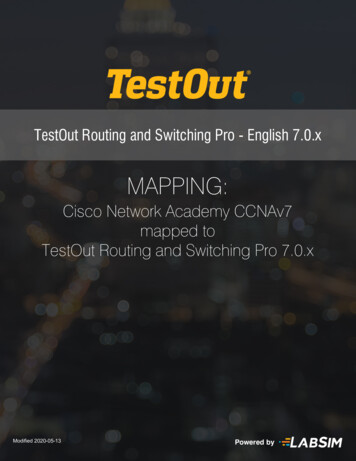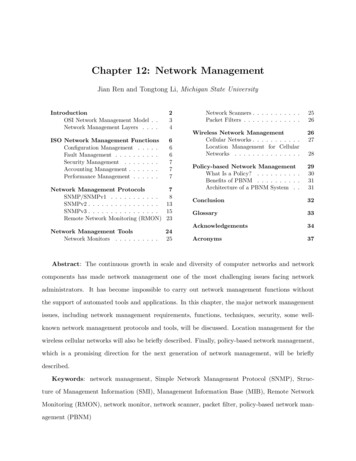
Transcription
1OSI MODELManinder Kaurwww.eazynotes.com
Introduction to OSI Model2 OSI model is based on the proposal developed by theInternational Standards Organization (ISO). This model is called ISO OSI (Open SystemsInterconnection) Reference model because it dealswith connecting open systems (systems that are openfor communication with other systems) We call it as OSI Model.Maninder Kaurwww.eazynotes.com
Principles on which OSI model was designed:3 A layer should be created where different level of abstractionis needed. Each layer should perform a well defined function. The function of each layer should be chosen according to theinternationally standardized protocols. The number of layers should be large enough that distinctfunctions should not be put in the same layer and smallenough that the architecture does not become very complex.Maninder Kaurwww.eazynotes.com
OSI ModelManinder Kaurwww.eazynotes.com4
OSI LayersManinder Kaurwww.eazynotes.com5
An Exchange Using the OSI ModelManinder Kaurwww.eazynotes.com6
Physical LayerManinder Kaurwww.eazynotes.com7
Physical Layer8 It is the bottom layer of OSI Model. It is responsible for the actual physicalconnection between the devices. Such physicalconnection may be made by using twisted paircable. It is concerned with transmitting bits over acommunication channel.Maninder Kaurwww.eazynotes.com
Functions of Physical Layer9 Transforming bits into signals Provides synchronization of bits by a clock. Physical layer manages the way a device connects to network media.It defines the transmission rate.It defines the way in which the devices areconnected to the medium.It provides physical topologiesIt can use different techniques of multiplexing.Maninder Kaurwww.eazynotes.com
Data Link LayerManinder Kaurwww.eazynotes.com10
Data Link Layer11 It is responsible for node-to-node delivery ofdata. It receives the data from network layer andcreates FRAMES , add physical address to theseframes & pas them to physical layer It consist of 2 layers:Logical Link Layer (LLC) : Defines themethods and provides addressing informationfor communication between network devices.Medium Access Control (MAC):establishes and maintains links betweencommunicating devices.Maninder Kaurwww.eazynotes.com
Functions of Data Link Layer12 Framing : DLL divides the bits received from N/Wlayer into frames. (Frame contains all the addressinginformation necessary to travel from S to D). Physical addressing: After creating frames, DLLadds physical address of sender/receiver (MACaddress) in the header of each frame. Flow Control: DLL prevents the fast sender fromdrowning the slow receiver.Maninder Kaurwww.eazynotes.com
Data Link Layer ExampleManinder Kaurwww.eazynotes.com13
Functions of Data Link Layer14 Error Control: It provides the mechanism of errorcontrol in which it detects & retransmits damaged orlost frames. Access Control: When single comm. Channel isshared by multiple devices, MAC layer of DLLprovides help to determine which device has controlover the channel.Maninder Kaurwww.eazynotes.com
Network LayerManinder Kaurwww.eazynotes.com15
Network Layer16 It is responsible for the source to destination deliveryof a packet across multiple networks. If two systems are attached to different networks withdevices like routers, then N/W layer is used. Thus DLL overseas the delivery of the packet betweenthe two systems on same network and the networklayer ensures that the packet gets its point of origin toits final destination.Maninder Kaurwww.eazynotes.com
Functions of Network Layer17 Internetworking: It provides Internetworking. Logical Addressing: When packet is sent outside thenetwork, N/W layer adds Logical (network) address of thesender & receiver to each packet. Network addresses are assigned to local devices by n/wadministrator and assigned dynamically by special servercalled DHCP (Dynamic Host Configuration Protocol) Routing: When independent n/w are connected to createinternetwork several routes are available to send the datafrom S to D. These n/w are interconnected by routers &gateways that route the packet to final destination.Maninder Kaurwww.eazynotes.com
Transport Layer18Maninder Kaurwww.eazynotes.com
Transport Layer19 It is responsible for process-to-process delivery of theentire message. TL looks after the delivery of entire message considering allits packets & make sure that all packets are in order. On theother hand n/w layer treated each packet independently. At the receiver side, TL provides services to applicationlayer & takes services form n/w layer. At the source side, TL receives message from upper layerinto packets and reassembles these packets again intomessage at the destination.Maninder Kaurwww.eazynotes.com
Transport Layer20 Transport Layer provides two types of services:Connection Oriented Transmission: In this typeof transmission the receiving devices sends anacknowledge back to the source after a packet or groupof packet is received. It is slower transmission method.Connectionless Transmission: In this type oftransmission the receiving devices does not sends anacknowledge back to the source. It is fastertransmission method.Maninder Kaurwww.eazynotes.com
Functions of Transport Layer21 Segmentation of message into packet &reassembly of packets into message. Port addressing: Computers run several processes.TL header include a port address with each process. Flow Control: Flow control facility prevents thesource form sending data packets faster than thedestination can handle. Error control: TL ensures that the entire messagearrives at the receiving TL without error.Maninder Kaurwww.eazynotes.com
Session Layer22Maninder Kaurwww.eazynotes.com
Session Layer23 Session layer is the fifth layer of OSI Model It has the responsibility of beginning, maintaining andending the communication between two devices, calledsession. It also provides for orderly communication betweendevices by regulating the flow of data.Maninder Kaurwww.eazynotes.com
Functions of Session Layer24 Establishing, Maintaining and ending a session:When sending device first contact with receiving device, itsends syn (synchronization) packet to establish aconnection & determines the order in which informationwill be sent. Receiver sends ack (acknowledgement). So thesession can be set & end. Dialog Control: This function determines that whichdevice will communicate first and the amount of data thatwill be sent. Dialog separation: Process of adding checkpoints &markers to the stream of data is called dialog separation.Maninder Kaurwww.eazynotes.com
Presentation Layer25Maninder Kaurwww.eazynotes.com
Presentation Layer26 Presentation layer is the sixth layer of OSI Model. It is concerned with the syntax & semantics of theinformation exchanged between the two devices. It was designed for data encryption, decryption andcompression.Maninder Kaurwww.eazynotes.com
Functions of Presentation Layer27 Data Presentation or Translation: Because differentcomputers use different encoding systems. It ensures thatthe data being sent is in the format that the recipient canprocess. Data Encryption: PL provides this facility by which hidesthe information from everyone except the person whooriginally sent the information & the intended recipient.When encrypted data arrives at destination, PL decryptsthe message. Data Compression: PL shrinks large amount of data intosmaller pieces i.e. it reduces the size of data.Maninder Kaurwww.eazynotes.com
Application Layer28Maninder Kaurwww.eazynotes.com
Application Layer29 It is the topmost i.e. seventh layer of OSI Model. It enables the user to access the network. It provides user interface & supports for services suchas e-mail, file transfer, access to the world wide web. So it provides services to different user applications.Maninder Kaurwww.eazynotes.com
Functions of Application Layer30 Mail Services: This application provides various e-mail services. File transfer & Access: It allows users to access filesin a remote host, to retrieve files from remotecomputer for use etc. Remote log-in: A user can log into a remotecomputer and access the resources of that computer. Accessing the World Wide Web: Most commonapplication today is the access of the World Wide Web.Maninder Kaurwww.eazynotes.com
Principles on which OSI model was designed: A layer should be created where different level of abstraction is needed. Each layer should perform a well defined function. The function of each layer should be chosen according to the internationally standardized protocols. The number of layers should be large enough that distinct functions should not be put in the same layer and small










